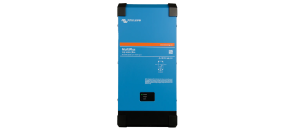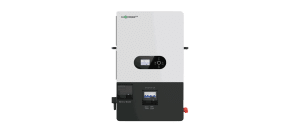
COMPATIBLE INVERTERS
Discover our selection of inverters / chargers compatible with our lithium batteries.
From $499.98
Thanks to the Volthium Hilo Synchronization Gateway, saving on your electricity bill has never been easier. Our gateway creates the smart link between your battery system and the electrical grid.
From $1,181.84
The MultiPlus is a device that combines an inverter and a charger in a single unit. Among its many features, it includes a pure sine wave inverter, adaptive charging, hybrid PowerAssist technology, and multiple system integration functions.
From $1,622.25
The MultiPlus is a device that combines an inverter and a charger in a single unit. Among its many features, it includes a pure sine wave inverter, adaptive charging, hybrid PowerAssist technology, and multiple system integration functions.
From $1,624.73
The MultiPlus-II combines the functions of the MultiPlus and the MultiGrid.
From $1,940.00
The SNA-US 6000 inverter (6 kW inverter / 8 kWp solar) from LuxPowerTek is an off-grid inverter. It complies with Canadian Electrical Code standards for installation in residential or commercial settings, allowing it to be used as a backup system against power outages and for solar energy production.
Simultaneously harness solar energy, battery storage, and grid power to supply your home or business with continuous and uninterrupted power of up to 6,000 W (25 A at 240 V).
In the event of a power outage, the Lux SNA-US 6000 (6K/8KpV) inverter can be used as a backup power system, with or without solar panels.
From $3,034.00
The SNA-US 12000K inverter (24 KPV) by LuxPowerTek is an off-grid inverter, commonly referred to as an off-grid power system. However, it meets Canadian Electrical Code standards and can be installed in residential or commercial settings to serve as a backup power system and solar production solution.
From $3,186.00
The SNA-US 15000K inverter (24 KPV) by LuxPowerTek is an off-grid inverter, commonly referred to as an off-grid power system. However, it meets Canadian Electrical Code standards and can be installed in residential or commercial settings to serve as a backup power system and solar production solution.
From $4,239.00
LuxpowerTek’s UL-certified hybrid bi-phase energy storage inverters are meticulously designed for optimal residential use. These inverters are not only compatible with low-voltage batteries but also feature independent AC coupling interfaces.
From $3,800.98
The Sol-Ark 5K-1P-N hybrid inverter designed to offer seamless integration with grid-tied, off-grid, or backup solar systems. This compact all-in-one solution simplifies energy management and installation while ensuring reliable power for essential appliances.
From $5,159.00
The LXP US 12K was designed by LuxpowerTek to meet the specific requirements of large-scale residential photovoltaic energy storage systems.
From $5,599.00
The GEN-LB-US 16K was designed by LuxpowerTek to meet the specific requirements of large-scale residential photovoltaic energy storage systems.
From $6,349.98
The Sol-Ark 5K-2P hybrid inverter is an all-in-one solution designed for seamless integration into Grid-tied, Off-Grid, or Battery Backup solar systems.
From $7,224.98
The Sol-Ark Essentials hybrid inverter offers a powerful and versatile solution for fueling your home with solar energy.
From $9,399.98
The Sol-Ark Whole Home hybrid inverter is the most powerful and versatile home energy storage solution on the market today.
Lithium batteries are one of the most common energy storage technologies today, widely used in a variety of applications, from electric and recreational cars (RVs), water vehicles, solar storage banks, medical and industrial applications. The basic principle of their operation is the mobility of lithium ions between the two electrodes: the anode (negative electrode) and the cathode (positive electrode), via an electrolyte.
- Composition: Lithium batteries are typically made up of three main components: the anode, cathode, and electrolyte. The anode is usually composed of carbon, most often in the form of graphite. The cathode of LifePO4 batteries such as the ones we manufacture is made of lithium iron phosphate, iron phosphate promotes a strong molecular bond, which withstands extreme load conditions, extends service life, and maintains chemical integrity over many cycles. For other lithium batteries, the cathode is usually composed of a lithium metal compound, such as lithium cobalt, lithiated manganese, lithium nickel, or a mixture of these elements. The electrolyte is a chemical substance that allows lithium ions to pass between the anode and the cathode. At Volthium, we believe that LifePO4 batteries are the best alternative for different reasons.
- During charging: When the battery is charged, i.e. when the current is applied, the lithium ions move from the cathode to the anode via the electrolyte. During this process, lithium ions are “inserted” into the anode structure, a process called intercalation.
- During discharge: When the battery is used to power a device, i.e., when it is discharged, lithium ions move from the anode to the cathode, a process that releases energy. The mobility of lithium ions from the anode to the cathode is what generates the energy needed to power the device.
- Capacity and durability: The capacity of a lithium battery is determined by the amount of lithium it can store, which in turn determines how much energy it can provide. However, it is normal for the capacity of a battery to decrease over time, a phenomenon known as battery degradation. This is due to several factors, including temperature, overcharging and discharging, and general battery usage. However, thanks to the quality of our batteries and in particular our grade A+ cells, our batteries are guaranteed for 10 years and offer a lifespan of about 15 years.
LiFePO4 batteries, known for their lithium iron phosphate composition, are distinguished by their durability and superior energy capacity, especially in demanding applications such as recreational vehicles (RVs), trailers, and cottages. In Canada, where the search for reliable and sustainable energy solutions is constant, lithium LiFePO4 batteries are increasingly preferred over traditional lead-acid batteries, thanks to their long lifespan that can reach up to 3000 cycles at 100% discharge without significantly damaging the remaining capacity of the battery.
Volthium offers a range of 12V and 200Ah LiFePO4 batteries, equipped with grade A cells guaranteeing optimal efficiency. These batteries offer a shorter charging time and greater energy capacity, making the installation of a solar panel for energy storage even more cost-effective. Their high charge rate and stable voltage allow any electrical equipment to be efficiently powered, without the risk of overheating, thanks to the intrinsically safe lithium iron phosphate technology.
There are several types of lithium batteries, which are usually differentiated by the material used for the cathode (the positive electrode). The most common types are lithium cobalt (LiCoO2), lithium manganese (LiMn2O4), lithium nickel manganese cobalt (NMC), lithium nickel cobalt aluminum (NCA), and lithium iron phosphate (LiFePO4 or LFP) batteries. Volthium batteries are Iron Phosphate batteries known as LiFePO4 and LFP which are a kind of lithium-ion battery. They differ from other types of lithium batteries in their use of iron-phosphate for the cathode, rather than cobalt or nickel. They are said to have the following qualities:
- Safety and stability: LFP batteries are known for their safety and superior thermal stability. Compared to other types of lithium batteries, they are less likely to overheat or catch fire if malfunctioned or misused. This increased safety is due to the intrinsic stability of iron phosphate.
- Durability and life cycle: They also have a long service life and can maintain a high load capacity even after many charge and discharge cycles. They have a low self-discharge rate, which means they can hold their charge for long periods of time without use. Our products offer more than 6000 cycles and have a service life of about 15 years.
- Environmental performance: In comparison, LFP batteries have a potentially lower environmental impact. Iron is more abundant and less toxic than cobalt and nickel, and iron mining has a lower environmental impact. In addition, LFP batteries are easier to recycle than other types of lithium batteries.
Reducing our dependence on fossil fuels, improving air quality, managing e-waste more responsibly ; Lithium batteries have had a significant positive impact on the environment, playing a critical role in the transition to a cleaner and more sustainable society. Their increasing adoption in various areas, such as electric vehicles and renewable energy storage, has helped to significantly reduce greenhouse gas emissions from transportation and power generation.
Lithium battery recycling has also become more efficient, allowing valuable materials such as lithium, cobalt, and nickel to be recovered and reused in new batteries or other applications.
DO YOU NEED
HELP IN DECIDING?
The best battery for your unique needs.














